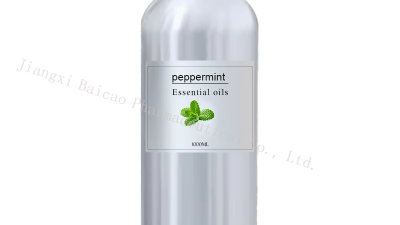7 Compelling Reasons to Choose the Best Carrier Oil for Peppermint Oil Benefits
Table of Contents
- The Importance of Choosing the Right Carrier Oil for Enhancing Peppermint Oil Benefits
- Understanding the Synergy: How Carrier Oils Amplify the Properties of Peppermint Oil
- Top Carrier Oils for Peppermint: A Comparison of Absorption Rates and Therapeutic Effects
- Scientific Insights: The Optimal Carrier Oil Ratios for Maximum Peppermint Oil Efficacy
- Safety Considerations: Allergies and Sensitivities When Using Peppermint Oil with Carrier Oils
- Cost-Effectiveness: Evaluating the Long-Term Value of Quality Carrier Oils in Aromatherapy
- Harnessing the Power of Steam Distillation: The Essential Role of Peppermint Oil in Cosmetic and Dermatological Applications
- FAQS
- Conclusion
- Related Posts
Lately, there’s been a real surge in demand for essential oils. It’s pretty crazy — the global market is expected to hit around USD 13.94 billion by 2026, growing at a rate of about 7.5% each year. Among all of these, peppermint oil is definitely a star. It’s super versatile, showing up in cosmetics, health products, and even food.
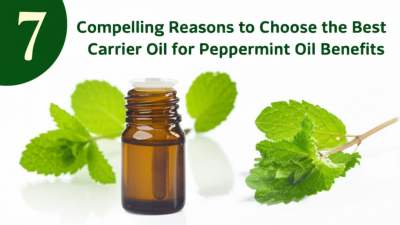
If you want to get the most out of peppermint oil, though, it’s super important to pick the right carrier oil. That way, you’re not only protecting your skin but also boosting the oil’s benefits. Carrier oils help dilute the peppermint oil for skin use, making it safer and easier for your skin to absorb, plus they help prevent any irritation.
On that note, Jiangxi Baicao Pharmaceutical Co., Ltd. is someone you might want to know about—they really know their stuff when it comes to natural flavor oils and plant-based essential oils, including top-quality peppermint oil made from local herbs.
In this post, I’ll share seven solid reasons why choosing the best carrier oil matters so much when working with peppermint oil. Whether you’re a consumer or a manufacturer, these tips will help you unlock the full potential of this popular essential oil.
The Importance of Choosing the Right Carrier Oil for Enhancing Peppermint Oil Benefits
So, when you're trying to get the most out of peppermint oil, picking the right carrier oil really matters. Think of carrier oils as the friendly base that mixes with essential oils, making sure they're safe to use on your skin. The right choice not only helps your skin absorb peppermint oil better but also boosts its energizing effects, giving you a more effective, well-rounded experience.
For example, lighter oils like fractionated coconut or sweet almond oil are great because they absorb pretty quickly, so they're perfect for spots like your temples or neck for headaches or muscle aches. Plus, they help spread the peppermint oil evenly across your skin, maximizing those relief benefits. On the flip side, richer oils like jojoba or olive oil tend to provide extra skin nourishment, which makes them ideal if you’re applying it more broadly or want some added moisture. When you choose your carrier thoughtfully, you’re not only making the peppermint oil more effective but also customizing the whole experience to suit what you need most.
Understanding the Synergy: How Carrier Oils Amplify the Properties of Peppermint Oil
Carrier oils are pretty essential when it comes to getting the most out of peppermint oil. They create this nice little synergy that really boosts its therapeutic effects. Basically, when you dilute peppermint oil with a good-quality carrier oil, it becomes so much easier to use on your skin. Plus, that fresh, minty scent can really help with headaches, muscle tension, and even help you focus better. Choosing the right carrier oil isn’t just about safety — it also helps the active ingredients in peppermint penetrate deeper into your skin, making them work even better.
**Pro tip:** Pick a carrier oil that matches what you want to use peppermint for. For example, coconut oil is awesome for moisturizing, so it’s great if you want to use it on your skin. Jojoba oil, on the other hand, mimics your skin’s natural oils perfectly, so it absorbs easily without clogging pores.
Adding carrier oils to your peppermint routine isn’t just about safety — it can actually make the oil more effective and give you extra perks. For instance, sweet almond oil is super nourishing for the skin and, combined with peppermint, can help reduce stress and tension. It makes a fantastic massage oil for sore muscles.
**A little tip:** Always do a quick patch test before slathering any oil mix all over your skin, just to make sure you’re not allergic or sensitive to it.
Top Carrier Oils for Peppermint: A Comparison of Absorption Rates and Therapeutic Effects
When you're digging into the benefits of peppermint oil and want to get the most out of it, choosing the right carrier oil is kinda key. Not all carrier oils are the same—some soak into your skin faster than others, which can really make a difference in how well the peppermint works and how quick you feel relief. For example, jojoba oil is known for being super quick to absorb, making it a great pick if you're applying topically for headaches or upset stomachs caused by peppermint. On the flip side, coconut oil takes a bit longer to sink in but brings some nice moisturizing properties that can boost that fresh, invigorating feeling you get from peppermint.
**A little tip:** When you're choosing your carrier oil, think about your skin type. If your skin is on the oily side, lighter oils like grapeseed might be your best bet. But if you've got drier skin, a heavier oil like avocado could be more your style. And hey, if you're into boosting hair growth, mixing peppermint with some rosemary essential oil in a carrier might do the trick—there's some research hinting that rosemary can support healthier hair.
Getting the right combo of peppermint oil and carrier oil doesn’t just stop there. It can actually help unlock more benefits. Studies suggest peppermint oil can ease digestion and help with headaches, while rosemary oil is known for its brain-boosting perks. When you pick your carrier oils thoughtfully, it’s like setting the stage for a more well-rounded wellness boost. Using these oils together can really amplify what they do, making it easier to tackle all those health needs in our busy, everyday lives.
7 Compelling Reasons to Choose the Best Carrier Oil for Peppermint Oil Benefits - Top Carrier Oils for Peppermint: A Comparison of Absorption Rates and Therapeutic Effects
| Carrier Oil | Absorption Rate | Therapeutic Effects | Comedogenic Rating | Best For |
|---|---|---|---|---|
| Jojoba Oil | Fast | Moisturizing, Anti-inflammatory | 2 | Oily and Combination Skin |
| Sweet Almond Oil | Medium | Soothing, Rich in Vitamins | 2 | Sensitive Skin |
| Coconut Oil | Slow | Antimicrobial, Moisturizing | 4 | Dry Skin |
| Grapeseed Oil | Fast | Antioxidant, Tightening | 1 | All Skin Types |
| Olive Oil | Medium | Nourishing, Rich in Antioxidants | 2 | Dry, Mature Skin |
Scientific Insights: The Optimal Carrier Oil Ratios for Maximum Peppermint Oil Efficacy
When you're trying to get the most out of peppermint oil, picking the right carrier oil is kind of a big deal. Some studies even show that certain carrier oils can help your body absorb peppermint better and boost its effects. A lot of people recommend mixing peppermint with carrier oils like jojoba or sweet almond oil in a 1:1 ratio—that means equal parts. This combo not only helps the peppermint penetrate your skin more effectively but also kicks up its cooling and energizing vibes. Pretty neat, right?
You might also want to try carrier oils like coconut or olive oil. Coconut is known for its antimicrobial perks, and olive oil’s packed with antioxidants—that’s good news for your skin. When you mix these with peppermint, just keep in mind a diluting ratio around 4:1 (carrier oil to peppermint) to make sure you get all the benefits without overwhelming your skin.
A couple of tips—always do a patch test first, just to be safe and avoid any irritation. And if you’re into DIY, try adding peppermint to homemade massage oils or stress-balms. Combining its minty aroma with calming oils like lavender can seriously elevate your aromatherapy game and help keep your skin healthy and glowing. Trust me, small tweaks like these can make all the difference!
Safety Considerations: Allergies and Sensitivities When Using Peppermint Oil with Carrier Oils
Whenever you're using peppermint oil, it's super important to keep safety in mind—especially if you've got allergies or sensitivities. The American Academy of Dermatology points out that essential oils like peppermint can sometimes cause allergic reactions in certain people, leading to skin irritation or even breathing problems. So, a quick heads-up: always do a patch test before slathering it on, okay? Just dab a tiny bit of diluted oil on a small patch of your skin and watch things over the next 24 hours to see if there's any reaction.
Here's a handy tip: stick with gentle carrier oils like jojoba or sweet almond oil. They tend to be less likely to cause irritation, especially if you have sensitive skin. According to the NIH, organic carrier oils keep their beneficial properties without messing with your skin’s health—making them a great choice to boost that calming effect of peppermint.
And if you have asthma or other respiratory issues, you need to be extra careful. The Journal of Essential Oil Research mentions that peppermint oil can be pretty strong and irritating if you breathe it in directly. Always dilute it with a carrier oil—think about mixing 2-3 drops of peppermint into a tablespoon of your chosen carrier oil. That way, you get to enjoy all its benefits without risking any breathing issues. Just a little caution goes a long way!
Safety Considerations When Using Peppermint Oil with Carrier Oils
Cost-Effectiveness: Evaluating the Long-Term Value of Quality Carrier Oils in Aromatherapy
Picking the right carrier oil for your peppermint essential oil isn't just about getting the most out of it—it's also a pretty smart move if you're into aromatherapy for the long haul. Carrier oils are basically necessary for thinning out essential oils, making sure you can use them safely without any worries, while also boosting their benefits. Sure, high-quality carrier oils might cost a bit more upfront, but honestly, they tend to last longer and work better, so in the end, they’re often more bang for your buck. That little extra investment really pays off, especially since you’ll usually need fewer drops to feel the effects.
When you're choosing a carrier oil, it's cool to look for ones that do double duty—like helping your skin stay healthy or giving your hair a bit of extra love. Jojoba and coconut oils are awesome because not only do they blend perfectly with peppermint oil, but they can also add some moisture to your skin or make your hair softer and more manageable. A good tip? Do a quick patch test first to make sure your skin’s not gonna freak out, and don’t be shy about playing around with different ratios until you find what feels just right.
And hey, if you really wanna save some cash, buying carrier oils in bulk is your friend. It helps bring down the cost per ounce and means you'll have plenty on hand for all your aromatherapy, skincare, or haircare projects. Just make sure to go for organic or sustainably sourced oils whenever you can—that way, you’re not only taking care of yourself but also doing a favor for the planet.
Harnessing the Power of Steam Distillation: The Essential Role of Peppermint Oil in Cosmetic and Dermatological Applications
Harnessing the Power of Steam Distillation: The Essential Role of Peppermint Oil in Cosmetic and Dermatological Applications
Peppermint oil, extracted through the meticulous process of steam distillation from the leaves of the peppermint plant, has emerged as a powerhouse ingredient in the realm of cosmetic and dermatological applications. This essential oil, characterized by its colorless or light yellow liquid form, is revered not only for its invigorating scent but also for its myriad of beneficial properties for skin and hair care. Rich in menthol, peppermint oil offers a refreshing sensation that can soothe irritation and provide a cooling effect, making it a sought-after component in various beauty formulations.
In cosmetic applications, peppermint oil plays a crucial role in enhancing the overall user experience. Its natural antiseptic properties help purify the skin, reducing the occurrence of acne and other blemishes. Additionally, the invigorating aroma of peppermint oil can elevate mood and promote relaxation, turning a daily skincare routine into a soothing self-care ritual. When incorporated into hair care products, this essential oil can stimulate circulation to the scalp, promoting healthier hair growth and adding a vibrant shine to locks. The versatile nature of peppermint oil makes it an essential ingredient for anyone seeking to enhance their beauty regimen with a touch of nature's finest offerings.
FAQS
: Carrier oils enhance the benefits of peppermint oil by ensuring better absorption and skin safety when applied topically, allowing for the therapeutic properties of peppermint oil to be maximized.
It is recommended to use a dilution ratio of 2-3 drops of peppermint oil per tablespoon of carrier oil to ensure safe usage and mitigate sensitivity.
For oily skin, lighter oils such as grapeseed are preferable, while heavier oils like avocado benefit those with dry skin. Jojoba oil is also a good option as it closely resembles natural skin oils.
Yes, when combined with carrier oils like sweet almond oil, peppermint oil can provide soothing relief for sore muscles, making it an excellent choice for massage oils.
A patch test should be performed on a small area of skin to check for allergic reactions or sensitivities before applying the oil mixture more broadly.
Yes, individuals with asthma or respiratory conditions should exercise caution, as peppermint oil can irritate when inhaled directly. Always dilute it properly with a carrier oil to reduce risks.
Yes, peppermint oil is recognized for its potential benefits in aiding digestion, especially when paired with a carrier oil that allows for effective skin absorption.
The absorption rate of carrier oils affects how well peppermint oil penetrates the skin; oils like jojoba absorb quickly, while others like coconut oil provide moisturizing benefits but absorb more slowly.
Combining peppermint oil with rosemary essential oil may enhance overall effectiveness, especially for promoting hair health and supporting brain function.
Yes, organic carrier oils retain beneficial properties and are less likely to irritate the skin, making them a suitable choice for enhancing the soothing effects of peppermint oil.
Conclusion
Picking the right carrier oil for your peppermint oil is pretty important if you want to get the most out of its benefits. The perfect carrier not only helps your skin or body absorb the peppermint better, but it also works alongside the oil to boost its effects—whether you're into medicinal uses, skincare, or just feeling healthier overall. Options like jojoba, coconut, and grapeseed oils each have their own unique way of absorbing and interacting with peppermint, so knowing a bit about how they work can really help you pick what’s best for your needs.
And don't forget, safety stuff is key too—be mindful of allergies or sensitivities when blending peppermint with any carrier oil. It’s also worth thinking about cost and quality—good, high-quality carrier oils might cost a bit more, but they’re often worth it in the long run for aromatherapy and health routines. When you choose the right carrier oil, you’re more likely to unlock all the good stuff peppermint has to offer, feeling better and getting the most out of your setup.
Related Posts
-

Unmatched Quality of Chinese Manufacturing for the Best Carrier Oil to Enhance Peppermint Oil
-
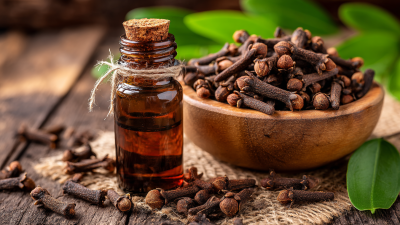
Unlocking the Secrets of Best Clove Bud Essential Oil: What You Need to Know for Quality Sourcing
-

Top Strategies for Sourcing Premium Cinnamon Oil for Culinary Excellence
-
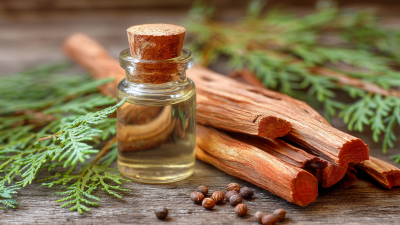
7 Amazing Benefits of Cedarwood Essential Oil for Your Skin
-
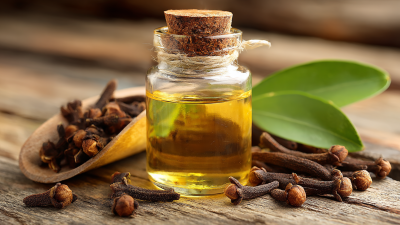
Understanding the Challenges of Sourcing Clove Oil In Tamil for Your Business
-

How to Effectively Use the Best Clove Oil for Acne: Real-Life Industry Success Stories


